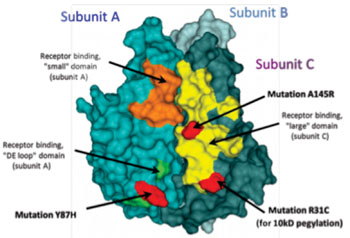Experimental Drug Slows Progress of Parkinson's Disease in Rat Model
By LabMedica International staff writers
Posted on 04 Aug 2014
In a series of experiments designed to set the stage for future human clinical trials, an experimental anti-inflammatory drug was shown to prevent loss of dopamine-producing neurons and to reduce motor deficits in a rat model of Parkinson’s disease (PD).Posted on 04 Aug 2014
Investigators at Emory University (Atlanta, GA, USA) had demonstrated previously that selective inhibition of soluble Tumor Necrosis Factor (solTNF) by injection into the brain (intranigral delivery) of dominant negative TNF (DN-TNF) inhibitors reduced neuroinflammation and nigral dopamine (DA) neuron loss in endotoxin and neurotoxin rat models of PD.

Image: XPro1595 is a clinical stage inhibitor of soluble TNFalpha (sTNF) for the treatment of neurodegenerative diseases including multiple sclerosis (MS), amyotrophic lateral sclerosis (ALS) and Parkinson’s disease (PD). As a result of its unique mechanism of action, XPro1595 is positioned as not only for symptomatic treatment for these devastating diseases but as a disease modifying therapy as well (Photo courtesy of FPRT Bio).
In the current study, they used a rat PD model in which the human disease was mimicked by injection of the animals in one side of the brain with the neurotoxin 6-hydroxydopamine (6-OHDA). The resulting syndrome reflected certain aspects of human PD: dopamine-producing neurons in the injected side of the brain died, leading to impaired movement on the opposite side of the body. The investigators sought to determine whether peripherally administered DN-TNF inhibitor XPro1595 could cross the blood-brain-barrier in therapeutically relevant concentrations and whether the drug would attenuate neuroinflammation and prevent loss of dopamine-producing neurons.
Xpro1595, which was developed by FPRT Bio (Scranton, PA, USA), is a novel protein therapeutic agent that neutralizes soluble TNF (sTNF) using Dominant-Negative TNF technology. The mode of operation of the drug is very simple, yet very elegant. Human sTNF exists as three identical monomers that bind neatly into the TNF receptor (TNFR). The binding of normal sTNF to the TNFR is required for the biologic effect. Xpro1595 is an engineered protein that has six amino acid substitutions that makes it slightly different from normal human sTNF. XPro1595 can freely bind with normal monomers to form heterotrimers, but the heterotrimers cannot bind to TNFR. This eliminates any biologic effects of the sTNF. Thus, XPro1595 completely and efficiently neutralizes sTNF. This is a unique biologic property of XPro1595 that has important therapeutic implications.
Results published in the July 24, 2014, online edition of the Journal of Parkinson’s Disease revealed that XPro1595 could reach the brain at sufficient levels to have beneficial effects when administered by subcutaneous injection. Rats dosed with XPro1595 three days after 6-OHDA injection lost only 15% of dopamine-producing neurons as compared to controls that lost 55% of the same neurons. Animals treated with XPro1595 two weeks after 6-OHDA injection lost 44% percent of dopamine-producing neurons, suggesting that there was a limited time frame for effective use of the drug.
“Recent clinical studies indicated there is a four or five year window between diagnosis of Parkinson’s disease and the time when the maximum number of vulnerable neurons are lost,” said senior author Dr. Malu Tansey, associate professor of physiology at Emory University. “If this is true, and if inflammation is playing a key role during this window, then we might be able to slow or halt the progression of Parkinson’s with a treatment like XPro1595.”
“This is an important step forward for anti-inflammatory therapies for Parkinson’s disease,” said Dr.Tansey. “Our results provide a compelling rationale for moving toward a clinical trial in early Parkinson’s disease patients. Inflammation is probably not the initiating event in Parkinson’s disease, but it is important for the neurodegeneration that follows. That is why we believe that an anti-inflammatory agent, such as one that counteracts soluble TNF, could substantially slow the progression of the disease.”
Related Links:
Emory University
FPRT Bio













